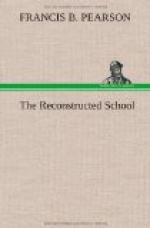In the thinking of most people democracy is a form of government; but primarily it is not this at all. Rather it is a spiritual attitude. The form of government is an outward manifestation of the inward feeling. Our ancestors held democracy hidden in their hearts as they crossed the ocean long before it became visible as a form of government. The form of government was inevitable, seeing that they possessed the feeling of democracy, and that they were journeying to land in obedience to the dictates of this feeling. In education for democracy the form of government is an after-consideration; that will come as a natural sequence. The chief thing is to inoculate the spirits of people with a feeling for democracy. This germ will grow out into a form of government because of the unity of feeling and consequent thinking. When this spiritual attitude is generated, not only does the form of government follow, but people meet upon the plane of a common purpose and give expression to their inner selves in like movements. They come to realize that, in a large way, each one is his brother’s keeper. They are drawn together in closer sympathy and good-will; artificial barriers disappear; and they all become interested in the common good. Their interests, purposes, and activities become unified, and life becomes better and richer. Actuated by a common impulse, they exemplify what Kipling says in his Sons of Martha:
Lift ye the stone or cleave the wood to
make a path more fair or flat,
Lo, it is black already with blood some
Son of Martha spilled for that,
Not as a ladder from Earth to Heaven,
not as an altar to any creed,
But simple Service, simply given, to their
own kind, in their common need.
As Dr. Henry van Dyke well says, “It is the silent ideal in the hearts of the people which molds character and guides action.”
It will be admitted without qualification that the school, when well administered, constitutes a force that a altogether favorable to the development of the spirit of democracy, and no one will deny that democracy is a worthy goal toward which the activities of the school should be directed. It is easy to see just how geography, for instance, may be made a means to this end. The members of the class represent many conditions of society, but in the study of geography they unite in a common enterprise and have interests in common. Thus their spirits merge and, for the time, they become unified in a common quest. They become coordinates and confederates in this quest of geography, and the spirit of democracy expands in an atmosphere so favorable to growth. These pupils may differ in race, in creed, or in color, but these differences are submerged in the zeal of a common purpose. Lines of demarcation are obliterated and they are drawn together because of their thinking and feeling in unison. The caste system does not thrive in the geography class and snobbery languishes. The pupils have the same books, the same assignments, the same teacher, and share alike in all the privileges and pleasures which the class provides. Their grades are given on merit, with no semblance of discrimination. In short, they achieve the democratic attitude of spirit by means of the study of geography.




